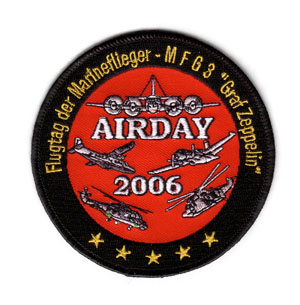
Air Day 2006
Nordholz, Germany
26-27 August 2006
|
Air Day 2006 Nordholz, Germany 26-27 August 2006
|
|
Canada took the opportunity to show its CP-140 Aurora. Not a stranger to Western European airfields, this CP-140 bears a sticker denoting "Aurora Incremental Modernization Project Group I". The Canadian Forces have embarked on a project to keep the aircraft's avionics and other equipment up to date. The project is being caried out in stages, hence the Group I title. Unfortunately, the Norwegian P-3 had been withdrawn just before the event and with no RAF Nimrod or French Navy Atlantique 2 present, these two types represented the classic maritime patrol aeroplanes. |
|
A number of civilian types have been developed int less sophisticated maritime patrol aircraft during recent years. Several examples of this class class of aircraft could be seen on the tarmac of Nordholz. To the left, an ATR.42-400MP from Italy's Guardia di Finanza. Tasked with border control, but also immigration control, enforcement of fiscal laws and anti smuggling activities, the Guardia di Finanza operates a large fleet of fixed and rotary wing types. Based at Pratica di Mare with 2ºGruppo Esplorazione Marittima, this example is one of two ATR.42's in service with the GdiF. |
|
Sweden's coast guard operates a trio of CASA C.212CE surveillance aircraft to protect the country's long shoreline. A slow aeroplane with a good enough endurance, the C.212 certainly is good basis for the surveillance mission over the Baltic Sea and the Bothnic Gulf. Apart from these civilian registered ones, the Swedish Air Force used to operate a similar aircraft, but this now appears to have been stored. |
|
Intended for non-combat oriented patrol missions over the open ocean, the French Navy purchased a quartet of Dassault Falcon 50 SURMAR (SURveillance MARitime) aircraft. These are all second hand business jets, fitted with a large rectangular observation window clearly visible here. They fly with flotiile 24F at Lorient / Lann - Bihoué and no doubt relieve the Breguet Atlantique 2 fleet from oceanic surveillance missions for which the Atlantique's mission fit is not always required.
|
|
Environmental pollution control is the prime
mission for a pair of German Navy and of course Nordholz based Dornier
Do.228-212(LM) aircraft. A total of four Do.228's is based at Nordholz, with
the first and the fourth of the quartet assigned the environmental
inspection mission. The other pair are transports.
|
|
Of the rotary types on show at Nordholz, this Super Lynx Mk.88A was certainly the greatest eye catcher. It was finished in a paint scheme of a Lynx prowling in the night on a naval ship, just visible on the helicopter's nose. It was placed on Nordholz's dummy frigate deck which is being used to train Lynx pilots in the art of deck landings. This installation also includes the grid in which can grip the helicopter's anchor to prevent it from rolling sideways after landing. The ship's superstructure is simulated by a stack of freight containers not visible in this view to the left and is necessary to produce the returned downwash in a real life situation.
|
|
Other fixed wing aircraft present included
pairs of German Air Force F-4F Phantoms and Tornados as well as two USAFE
F-15E Strike Eagles. The latter were placed in a corral with motion sensors,
no doubt to prevent them being tampered with by visitors not so friendly
with the US. It is not to be hoped that this idea will spread, as it will
make photography all the more difficult.
To close this feature, a view of the Austrian Air Force PC.7 3H-FG painted in an attractive colour scheme.
|
All these images were aquired during the Spotters Day on 26 August which preceded the actual air show the following day. Thanks therefore to those making possible this preview day, which provided a very good opportunity to photograph the aircraft present without the barriers and crowd that go along with airshows.
All pictures (c) Hans Rolink